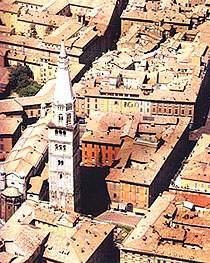
|
Meet Modena via "Swim Star 2000"
"5. Trofeo Ghirlandina",
Modena, Italy, June 2-4, 2000
|
Modena was a Roman colony and
later and important commune, which in 1288 came into the possession of the
D’Este Family. In 1598 when Cesare D’Este was obliged to give the territories
of Ferrara and Romagna to the Church, it became capital of Dukedom. Today
it is the main city of an important economic area, built on a system of flourishing
small and medium businesses, concentrated in Modena itself, the ceramics
area of Sassuolo, the knitwear area of Carpi and, a special gem, Ferrari
in Marranelo.
 Modena,
in the heart of Europe
Modena,
in the heart of Europe
|

 The complex which today is
by far the most important in Modena: the 17th century Ducal Palace
(Palazzo Ducale), one of the most significant baroque buildings in Italy.
Great exhibitions are held there today.
The complex which today is
by far the most important in Modena: the 17th century Ducal Palace
(Palazzo Ducale), one of the most significant baroque buildings in Italy.
Great exhibitions are held there today.

S.
Agostino - the room called the Camerino dei Confirmati contains the well
known "Stolen Bucket" which the Modenese captured from the Bolognese in 1325,
an episode recounted in Tassoni's poem.
|


In front of
the Ducal Palace
|
|
The symbol, heart and soul
of the city are found in piazza, Piazza Grande, meeting point between
religious identity and political power. Significant testimony of history and
art are found there.
 Piazza Grande
with the Comunale Palace and the Ghirlandina Tower
Piazza Grande
with the Comunale Palace and the Ghirlandina Tower
|


Igor and Dejan
at Piazza Roma
|

The Cathedral of Modena
is one of the biggest expressions of Romanesque art: built 1099 to the architect
Lanfranco’s design it was embellished by remarkable sculptures by Wiligelmo.

The Cathedral
of Modena
|


Igor Rasula
has just tested this Ferrari
|
|

Map of the
old Modena's Center
|


In front of
Aurora restaurant in via Taglio street, where we used to take a rest
|

 At its side the Ghirlandina
Tower stands 88 m high, symbol of the city. The Town of hall and the 16th
century clock tower enclose the Piazza Grande on two sides.
At its side the Ghirlandina
Tower stands 88 m high, symbol of the city. The Town of hall and the 16th
century clock tower enclose the Piazza Grande on two sides. |


In Via L.C.
Farini Street, a look from Piazza Roma and Military Academy
|
|
 Also the important monument
in Modena consists of the two great 18th century structures, symbol of the
D'Este family's munificence, especially that of Francesco III: the Hospital
and the Poor House which are some way from the Ducal Palace in Via Emilia
in the direction of Reggio. Today it is the "Palazzo of the museums" which
contains objects and books collected by the dukes, collections dating in
particular to the period of Francesco I (mid 17th century), and a remarkable
collection of paintings of which the most outstanding are by Corregio. The
library is linked to a long line of Modenese erudite cultural tradition:
Bacchini, Muratori and Tiraboschi.
Also the important monument
in Modena consists of the two great 18th century structures, symbol of the
D'Este family's munificence, especially that of Francesco III: the Hospital
and the Poor House which are some way from the Ducal Palace in Via Emilia
in the direction of Reggio. Today it is the "Palazzo of the museums" which
contains objects and books collected by the dukes, collections dating in
particular to the period of Francesco I (mid 17th century), and a remarkable
collection of paintings of which the most outstanding are by Corregio. The
library is linked to a long line of Modenese erudite cultural tradition:
Bacchini, Muratori and Tiraboschi.
Our accommodation was
in Via Orsola street in the historic center of Modena at S. Filipo Neri Youth
hostel. It is about 200 m from the Ducal Palace. Fantastic hospitality of
all people there we'll always remember. And we decided we'll be there next
year for sure.
|





 Piazza Grande
with the Comunale Palace and the Ghirlandina Tower
Piazza Grande
with the Comunale Palace and the Ghirlandina Tower





